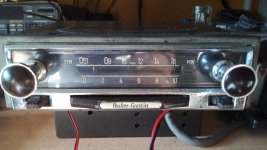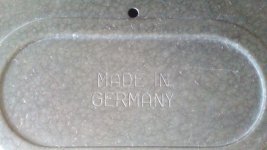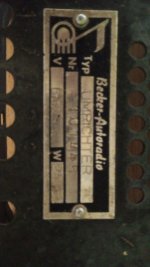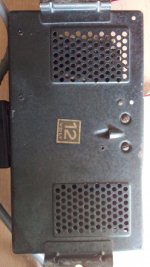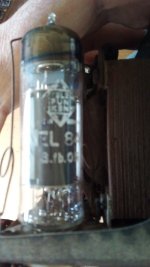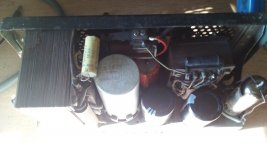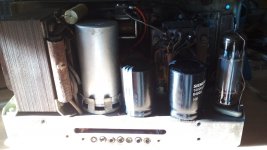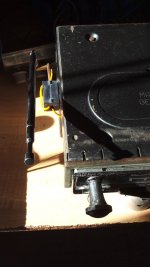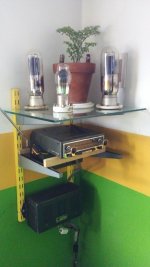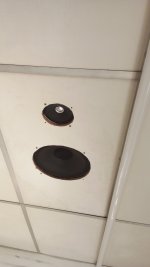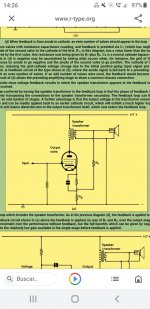I had been re-restoring this vintage autorradio made in Germany about 1960. This set has several years with me: it was gifted to me by Félix LU5DBX and was used few time and performs 9 pin tubes of the E series but one, the RF amplifier EC92: ECH81 mixer & oscillator, EBF89 IF & detector, EABC80 audio and carrier level detector, ECC85 relay driver and EL84 audio output. I replaced 'lytics with newer units and the EC92 triode is now a EF94 RF pentode rewiring the socket.
It has permeability tuning mechanism and a spring driven brass gear made to search stations according to 3 selectable strenght field in the front by a switch. The seeking function is called depressing the bar under the dial. A 3 fixed tone settings: normal, bassy and trebbly are available according to the position of the switch under the volume control knob at the left of the dial.
Only MW AM, no SW or FM.
The power unit uses a 115Hz vibrator that had to be opened and cleaned, the contacts was good. Very usefull data about vibrators and their habbits was found at:
https://www.cool386.com/msp/msp.html
and from a pdf free available from Mallory including designing of the transformer and waveforms. The rectifier is a Greatz bridge with selenium diodes in a block.
It is 12V by nature. Several capacitors was replaced by newer units using Siemens pieces trying to maintain german parts as I can. Also some brazilian parts as substitute.
The gear train was cleaned with solvent and oiled as it was solidified and dirty.
Note the newer 10mF @ 50V Siemens cap close to the vibrator, giving more clearace from it for better ventilation and aspect.
I added another 10mF @50V cap to form a pi filter with the internal inductor (original) and cooperates to reduce ripple in the vibrator circuit. Also, the cathode bypass is replaced by a newer unit 4.7mF @ 25V all from the Siemens trade to maintain german heritage.
The output stage is inside the vibrator power supply: EL84, matching transformer and coulpling network to EABC80's triode plate. The cathode biasing net of the EL84 doesn't return to ground directly but though secondary of the OT giving some few dB of negative feedback. The secondary has a tap, perhaps to accept 4 or 8 ohms speakers. The entire secondary is used to perform NFB. As a comment, there are two unused holes of the size of two new absent sockets. So, I suppose that it can accept another EL84 and (perhaps) a phase splitter to make a push pull output stage.
The restoring lavour is finished and the pet now has its new and own site at home.
It has permeability tuning mechanism and a spring driven brass gear made to search stations according to 3 selectable strenght field in the front by a switch. The seeking function is called depressing the bar under the dial. A 3 fixed tone settings: normal, bassy and trebbly are available according to the position of the switch under the volume control knob at the left of the dial.
Only MW AM, no SW or FM.
The power unit uses a 115Hz vibrator that had to be opened and cleaned, the contacts was good. Very usefull data about vibrators and their habbits was found at:
https://www.cool386.com/msp/msp.html
and from a pdf free available from Mallory including designing of the transformer and waveforms. The rectifier is a Greatz bridge with selenium diodes in a block.
It is 12V by nature. Several capacitors was replaced by newer units using Siemens pieces trying to maintain german parts as I can. Also some brazilian parts as substitute.
The gear train was cleaned with solvent and oiled as it was solidified and dirty.
Note the newer 10mF @ 50V Siemens cap close to the vibrator, giving more clearace from it for better ventilation and aspect.
I added another 10mF @50V cap to form a pi filter with the internal inductor (original) and cooperates to reduce ripple in the vibrator circuit. Also, the cathode bypass is replaced by a newer unit 4.7mF @ 25V all from the Siemens trade to maintain german heritage.
The output stage is inside the vibrator power supply: EL84, matching transformer and coulpling network to EABC80's triode plate. The cathode biasing net of the EL84 doesn't return to ground directly but though secondary of the OT giving some few dB of negative feedback. The secondary has a tap, perhaps to accept 4 or 8 ohms speakers. The entire secondary is used to perform NFB. As a comment, there are two unused holes of the size of two new absent sockets. So, I suppose that it can accept another EL84 and (perhaps) a phase splitter to make a push pull output stage.
The restoring lavour is finished and the pet now has its new and own site at home.
Attachments
Last edited:
The oscillogram avobe shows the PSU waveform.
Under no circumstance I will replace it with transistorized device as is sugested elsewhere in the net. No need to do such a sacrilege.
Its EL84 hardly drives those 10" speaker and 4" tweeter at the ceiling.
Under no circumstance I will replace it with transistorized device as is sugested elsewhere in the net. No need to do such a sacrilege.
Its EL84 hardly drives those 10" speaker and 4" tweeter at the ceiling.
Attachments
I didn't think you could have negative feedback in tube amps due to the phase shifting that you get through the output transformer. I guess that shows what I know about tube amps.
It's nice to see something old being kept in good working order.
It's nice to see something old being kept in good working order.
It has been so wired from factory. I didn't change the wiring, only replaced old caps by newer units trying to maintain its spirits. But the cathode bias network returns to the live wire of the speaker as I said. There is no cap across primary of the traffo and has a relatively large core size for a single tube.
This mode of NFB I had seen it previously in some TV and radio sets of the tube era.
How or where to place a 30 sec video showing the pet in action? Which video format is prefered?
Kind regards.
This mode of NFB I had seen it previously in some TV and radio sets of the tube era.
How or where to place a 30 sec video showing the pet in action? Which video format is prefered?
Kind regards.
Hi Perry,I didn't think you could have negative feedback in tube amps due to the phase shifting that you get through the output transformer. I guess that shows what I know about tube amps.
It's nice to see something old being kept in good working order.
There are old books like Terman's Electrical and Radio Engineering that show how to (carefully) apply multi-stage inverse feedback around output transformered vacuum tube amps.
When I used to restore old receivers, to look authentic, I was dedicated (actually nutty) enough to remove the guts from old canned electrolytics and install modern caps inside. Did the same, transistorizing old vibrators.
I'm sure others are doing it, even now. Just haven't had time to look.
I bought a nice old Grunow tabletop Superhet about 30 years ago. 5 years ago, I finally looked inside and was disappointed by the number of "updated" Japanese electrolytics inside. Hardly a "restoration".
My Best,
Ron
Last edited:
It's generally, but not always, better to apply stage-by-stage feedback. Less phase shift to deal with. The simplest example is a cathode, emitter or source follower. The first broadband examples were Tektronix o'scopes, with stage-by-stage FB and tapped plate delay lines.In this case, NFB is around the final stage alone and it is easier to apply it.
- Home
- General Interest
- Car Audio
- Becker Brescia tube autoradio restoration.
